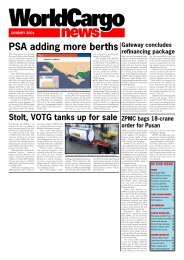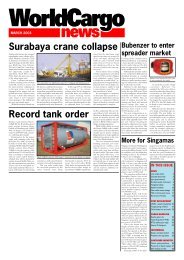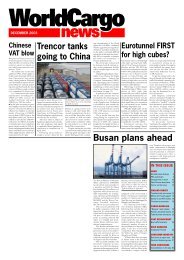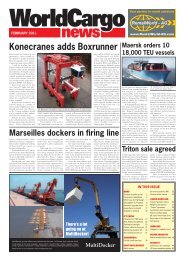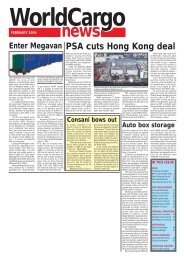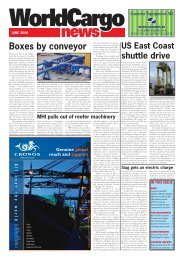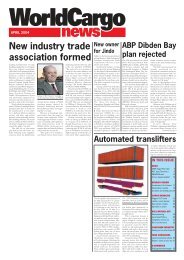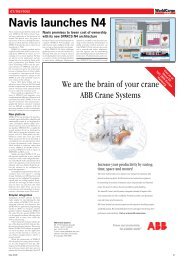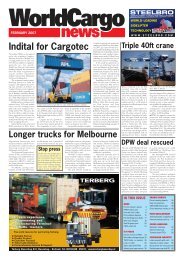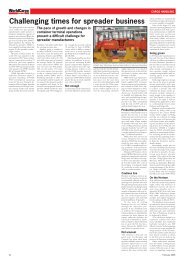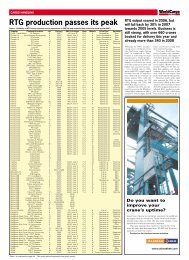Tanjung Priok super port - WorldCargo News Online
Tanjung Priok super port - WorldCargo News Online
Tanjung Priok super port - WorldCargo News Online
Create successful ePaper yourself
Turn your PDF publications into a flip-book with our unique Google optimized e-Paper software.
PORT DEVELOPMENT<br />
With<br />
In Russia’s Far East region, it owns<br />
Vostochnaya Stevedoring Co which<br />
has a terminal with a design capacity<br />
of 550,000 TEU. In addition, GPI is<br />
an im<strong>port</strong>ant player in the transit cargo<br />
market, owning Multi-Link Terminals<br />
in Finland, which operates small container<br />
terminals in Helsinki (Vuosaari)<br />
and Kotka as well as three inland depots.<br />
APMT and GPI will look at additional<br />
investments and the Black Sea area appears<br />
to be an obvious area for an operating<br />
presence at some stage. But for<br />
the time being the focus is on business<br />
integration and process management<br />
according to Fejfer, including in areas<br />
DP World will add 1M TEU of capacity at<br />
Jebel Ali Container Terminal 2 by the end of<br />
2013 and 4M TEU will go into operation at<br />
the new Terminal 3 complex in 2014<br />
such as operations, procurement and IT.<br />
Mid range players<br />
Medium-sized terminal operating companies<br />
also view emerging markets as<br />
solid investment op<strong>port</strong>unities. Some examples<br />
include:<br />
• Grup TCB is spreading out from its<br />
Spanish homeland (originally Barcelona)<br />
to Brazil, Colombia, Cuba, Mexico,<br />
Guatemala and Turkey.<br />
• Philippines-based International Container<br />
Terminal Services Inc (ICTSI) is<br />
active in many countries, including China,<br />
the Philippines, Indonesia, Madagascar,<br />
Georgia, Croatia, Poland, Argentina,<br />
Brazil, Colombia, Ecuador and Mexico.<br />
• Turkey’s Yil<strong>port</strong> is contemplating<br />
projects in Ecuador, Colombia, Ghana<br />
and elsewhere in West and East Africa.<br />
Although the GTOs’ main focus appears<br />
At the heart of every industry,<br />
At the centre of every movement<br />
to be on emerging markets it does not mean<br />
that Europe and North America are being<br />
ignored. Indeed, APMT and DP World<br />
are both involved in very large projects in<br />
Rotterdam, each developing multi-million<br />
TEU capacity, highly automated facilities<br />
in the Maasvlakte II area of the <strong>port</strong>.<br />
APMT is also a 30% shareholder in<br />
the recently opened Jade Weser Port<br />
(JWP) in Wilhelmshaven, Germany,<br />
where it works with Eurogate. In April, a<br />
technical and economic feasibility study<br />
on a northern extension to the JWP<br />
container terminal was launched (see<br />
page 55). Elsewhere in Europe, APMT<br />
has upgrade programmes in place at<br />
Gothenburg, Algeciras and Poti, Georgia<br />
(see page 48).<br />
DP World, meanwhile, is set to open<br />
its eagerly awaited London Gateway<br />
(LG) terminal on the River Thames in<br />
Q4/2013. Initially, it will have the capacity<br />
to handle 1.6M TEU. However, a short<br />
ramp up period will allow the operator<br />
to process over 3.5M TEU by early 2015.<br />
The adjacent rail-connected logistics<br />
park, which is capable of accommodating<br />
up to 925M m 2 of warehousing space,<br />
distinguishes the new <strong>port</strong> from other<br />
deepsea container <strong>port</strong>s in the UK. It has<br />
been described by the terminal operator<br />
as a “potential game changer” when it<br />
comes to the organisation of future shipping<br />
and freight distribution networks in<br />
the country.<br />
Value added approach<br />
DP World CEO Mohammed Sharaf sees<br />
LG as demonstrating the Dubai-based<br />
group’s increasingly value-added-driven<br />
approach to the terminals business. He<br />
thinks that supply chains will become<br />
more im<strong>port</strong>ant in determining a company’s<br />
success and its ability to compete.<br />
At the same time, the op<strong>port</strong>unity to offer<br />
customers choices should help shield<br />
DP World from having to compete on<br />
price alone.<br />
Yet DP World has not revealed the<br />
identity of any customers, despite parties<br />
close to LG suggesting at least one<br />
shipping line or carrier grouping will be<br />
calling from day one with several services.<br />
Discussions are also known to be taking<br />
place with a number of potential clients<br />
for the logistics park, thought to include<br />
UK-based retailers including Marks &<br />
Spencer and specialist logistics groups.<br />
In April, Peter Ward, commercial manager<br />
of the cargo supply chain at LG,<br />
confirmed that 380,000 ft 2 of multi-use<br />
warehousing would be built.<br />
“A few months ago we started testing<br />
the concept of developing common-user<br />
facilities in the logistics park and it was<br />
soon apparent that our plan was oversubscribed.<br />
We are now evaluating a similar<br />
approach for small and medium-sized<br />
enterprises engaged in the fresh food and<br />
time-sensitive environment,” he explained.<br />
Behemoth challenges<br />
A mounting challenge faced by <strong>port</strong>s<br />
and terminals, especially the larger ones,<br />
is how to handle much larger ships safely,<br />
securely and, invariably, in existing<br />
berthing windows. It can mean having<br />
to process as many as 6,000 containers a<br />
day – twice the handling rate achieved by<br />
most operators currently – and that inevitably<br />
involves more automation.<br />
Various levels of automation are becoming<br />
evident in most new terminals,<br />
especially in countries where salaries are<br />
high and there is an absence of strong union<br />
opposition. Automation is also more<br />
common when new terminals are developed<br />
and/or where there are specific<br />
safety or security issues.<br />
For instance TCB, which operates TC<br />
Buen at Buenaventura in Colombia, has<br />
invested about US$3.5M on installing<br />
various OCR systems on its ship-to-shore<br />
gantries, yard cranes and at the gates. It<br />
allows the terminal operator to optimise<br />
and allow real-time traceability on all containers<br />
entering and leaving the facility.<br />
In contrast, only a few operators have<br />
introduced radically new systems and/or<br />
automated processes at existing terminals<br />
because doing this while still trying to continue<br />
day-to-day operations presents huge<br />
challenges, both operationally and fiscally.<br />
Costly investments<br />
Automation is expensive, as is the cost of<br />
investing in the bigger cranes, stronger<br />
60<br />
May 2013



